Visual illusions come in many forms. The main category is concerned with transforming 2-dimensional surfaces into 3-dimensional space. Another category is involved with the suggestion of movement.
Attempt to Timeline
– 30.000
The Mind in the Cave.
Chauvet Cave, France. See also here.
Chances are shadow-play and sound were the first immersive acts in prehistoric times.
Some have suggested a ‘camera obscura’ effect was deliberately used.
By referring to cave ‘paintings’ as merely paintings, the three-dimensionality of the cave surfaces, the acoustics, the torch or oil lamp flickers, and the enveloping darkness of the whole space is ignored.
These are, without a doubt, multimedia installations.
– 17.000
Anamorphosis.
Lascaux Cave, France.
Almost undetectable on photographs, the Lascaux animals obtain an extra dimension by the use of anamorphosis: the paintings are adapted to the visitor’s viewpoints.
-15.000
Thaumathrope.
Found in 1868 in Laugerie-Basse (Vézere Valley, near Lascaux), this double-sided little disc made of bone shows an engraved deer in two positions.

-600
Catropic Cistula.
The most elaborate catoptric chests known from Ancient Rome exhibited detailed scenes, including expansive libraries, forests, cities, or even vast treasures. Another form of entertainment involved placing an animal, such as a cat, inside a chest, and watching it interact with numerous other cats that appeared to surround it.
-450
Distorted perspectives.
The ancient historians Pliny and Tzetzes both record a sculpture competition between Alcamenes and Phidias to create an image of Minerva. Alcamenes’ sculpture was beautiful, while Phidias’ had grotesque proportions. Yet once both had been mounted on pillars, the decelerated perspective made Phidias’ Minerva beautiful and Alcamenes’ ugly.
-400
Allegory of the cave.

Plato has Socrates describe a group of people who have lived chained to the wall of a cave all of their lives, facing a blank wall. The people watch shadows projected on the wall from objects passing in front of a fire behind them, and give names to these shadows. The shadows are the prisoners’ reality.
-464
Trompe-l’œil.
Trompe-l’œil (/trɒmp ˈlɔɪ/tromp LOY, French: [tʁɔ̃p lœj]; French for “deceive the eye”) is an art technique that uses realistic imagery to create the optical illusion that the depicted objects exist in three dimensions.
A version of an oft-told ancient Greek story concerns a contest between two renowned painters. Zeuxis (born around 464 BC) produced a still life painting so convincing that birds flew down to peck at the painted grapes. A rival, Parrhasius, asked Zeuxis to judge one of his paintings that was behind a pair of tattered curtains in his study. Parrhasius asked Zeuxis to pull back the curtains, but when Zeuxis tried, he could not, as the curtains were included in Parrhasius’s painting—making Parrhasius the winner.
20
Panoptic vistas.
Wall to wall murals, Pompeii
1420
Linear perspective.
Filippo Brunelleschi (1377 – 1446) develops the mathematical technique of linear perspective.

Originally, the design included an actual ledge, used as an altar, physically projecting outward from the now-blank band between the upper and lower sections of the fresco; further enhancing the sense of depth and reality in the work. Constructed as a pillared-shelf ~5 ft. above the floor, and estimated to be about 60 cm. wide, the altar-table’s appearance would have been intended to match and/or complement the painted architecture. Its facing-edge and upper surface integrating with the fresco’s steps and archway; and its supporting pillars, both real and illusory, combining with the shadows caused by the over-hang to create a crypt-like effect for the tomb beneath. (via Wikipedia).
1437
Peep show.
Around 1437 Italian humanist author, artist, architect, poet, priest, linguist, philosopher and cryptographer Leon Battista Alberti is thought to have created the earliest impressive peep show boxes with painted pictures to be viewed through a small hole. He had two kinds: night scenes with the moon and stars, and day scenes. It is thought these pictures may have been transparent and lit from behind, possibly changing from day to night by changing the lighting. It has also been suggested that it may have been a predecessor of the magic lantern that could project images.
1533
The Ambassadors.

Holbein’s The Ambassadors with a memento mori anamorph skull in the foreground.

1570
Zograscope.
1584
Pepper’s Ghost.
First described by Giambattista dellla Porta, the Pepper’s Ghost illusion was popularized, and given its name, by John Henry Pepper in 1862.
Let there be a chamber wherein no other light comes, unless by the door or window where the spectator looks in. Let the whole window or part of it be of glass, as we use to do to keep out the cold. But let one part be polished, that there may be a Looking-glass on bothe sides, whence the spectator must look in. For the rest do nothing. Let pictures be set over against this window, marble statues and suchlike. For what is without will seem to be within, and what is behind the spectator’s back, he will think to be in the middle of the house, as far from the glass inward, as they stand from it outwardly, and clearly and certainly, that he will think he sees nothing but truth. But lest the skill should be known, let the part be made so where the ornament is, that the spectator may not see it, as above his head, that a pavement may come between above his head. And if an ingenious man do this, it is impossible that he should suppose that he is deceived.

1646
Magic Lantern.
Athanasius Kircher published Ars Magna Lucis et Umbrae, on the subject of the display of images on a screen using an apparatus similar to the magic lantern. Kircher described the construction of a “catotrophic lamp” that used reflection to project images on the wall of a darkened room.
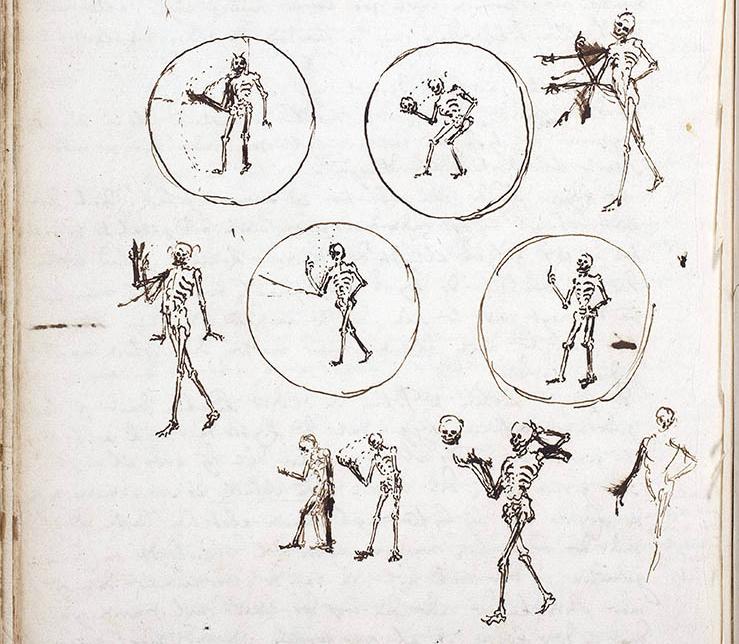
1781
The Mighty Eidophusikon.
Described by the media of his day as “Moving Pictures, representing Phenomena of Nature”, the Eidophusikon can be considered an early form of movie making. The effect was achieved by mirrors and pulleys.
The Eidophusikon consisted of a large-scale miniature theatre that let experiment the try of creating the perfect illusion of the moving nature: sunrise scenes, sunsets, moonlight images, storms, and volcanoes from all over the world with sound and music effects. The sound and light effects of the Eidophusikon, compared with the shows seen until that time, were specially inventive by their realism. (via Wikipedia)
1787 – 1792
Panoramas & Cycloramas.
The word “panorama”, from Greek pan (“all”) horama (“view”) was coined by the Irish painter Robert Barker in 1792 to describe his paintings of Edinburgh, Scotland shown on a cylindrical surface, which he soon was exhibiting in London, as “The Panorama”.
Related: Cycloramas were very popular in the late 19th century. The most popular traveled from city to city to provide local entertainment — much like a modern movie. As the viewers stood in the center of the painting, there would often be music and a narrator telling the story of the event depicted. Sometimes dioramas were constructed in the foreground to provide additional realism to the cyclorama. Circular and hexagonal-shaped buildings were constructed in almost every major US and European city to provide a viewing space for the cycloramas.

1822
Daguerre and Bouton’s diorama.
… “a mammoth synthesis of the panorama, illusionistic painting, and stage design – a theatre without actors and stories”…
(Erkki Huhtamo, ‘Illusions in Motion’, MIT 2013, p. 141)
The original diorama combines the immersive monumentality of the panorama with theatrical tricks, creating an ‘alcove space’. The frame is used to enhance the perception of depth. The diorama’s came to life using light- and sound-effects.

The Diorama was an invention of painter Charles-Marie Bouton and painter/inventor Daguerre.
1822
Polyorama Panoptique.
A miniature, portable variation on Daguerre’s diorama, consisting of a large lens and a painting or colored print on cardboard. By cutouts or semi-transparent additions the image changes colour depending on the surrounding light situation.
The Polyorama was sold as a souvenir of the auditorium-sized diorama shows.
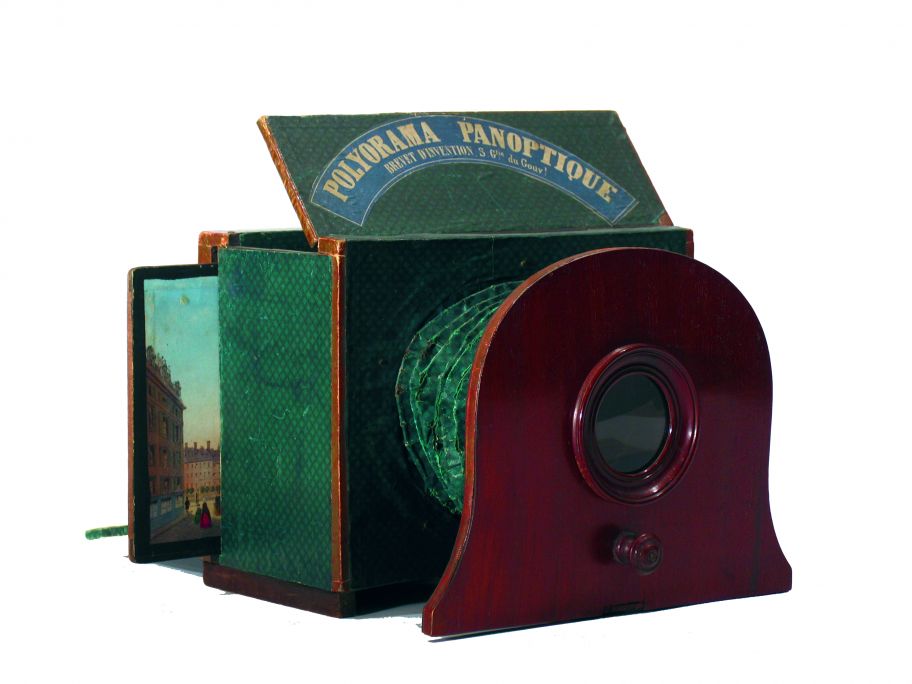
1829
Anorthoscope.
Only named Anorthoscope around 1836, this anamorphic disc image turned into normal proportions when it was rotated at some speed.
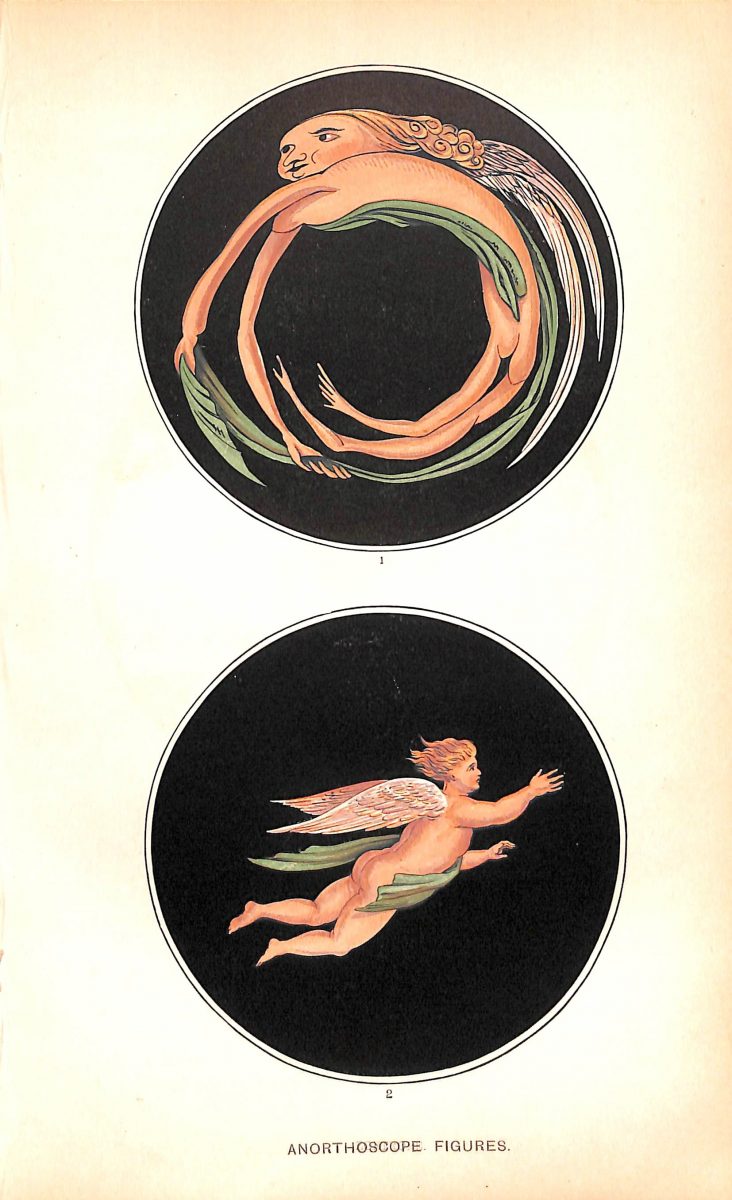
1833
Phenakistiscope.
A revolving cardboard disc showing the first ‘real’ (in the sense of ‘smooth’) animated image in a perpetual loop. The device was originally developed for scientific research into visual illusions.

The phenakistiscope found a second life as a picture disc: printed vinyl records.
1838
Photography.
1833 – 1838
Stereoscopy.
Busy bee Charles Wheatstone was involved in a wide range of inventions and innovations, from acoustics and musical instruments to the telegraph, measuring devices, cryptography, and optics.
His theory of using stereopsis – and two images instead of one – to achieve depth in a flat surface came just before the definite breakthrough of photography.
Stereopsis – the 3-dimensional image we build up from the two, slightly parallax views our eyes register – was described before: for instance by Leonardo Da Vinci.
A notable genre in stereography was the ‘diablerie’, a French series of stereo images, immensely popular in the 1860s.
Note: Queen’s Brian May – also an astronomer – made a Diableries book. Here he is explaining it.

The Kaiserpanorama was a rotund stereoscopic device, also known as the Photoplasticon.

1868
Kineograph, or flip book.
The concept may very well have existed long before John Barnes patented the ‘kineograph’; the first animation that was not circular, but linear.

1879
Zoopraxiscope.
Conceived by Eadweard Muybridge in 1879, and built in 1880 to project his chronophotographic images.
1887
Electrotachyscope.
A circular animation device, able to project its image: a large glass disc, rotated by hand was lit with a stroboscopic lamp.
1894
Mutoscope.

Based on the idea of a flip-book, a mutoscope would provide a private viewing of a short animation.
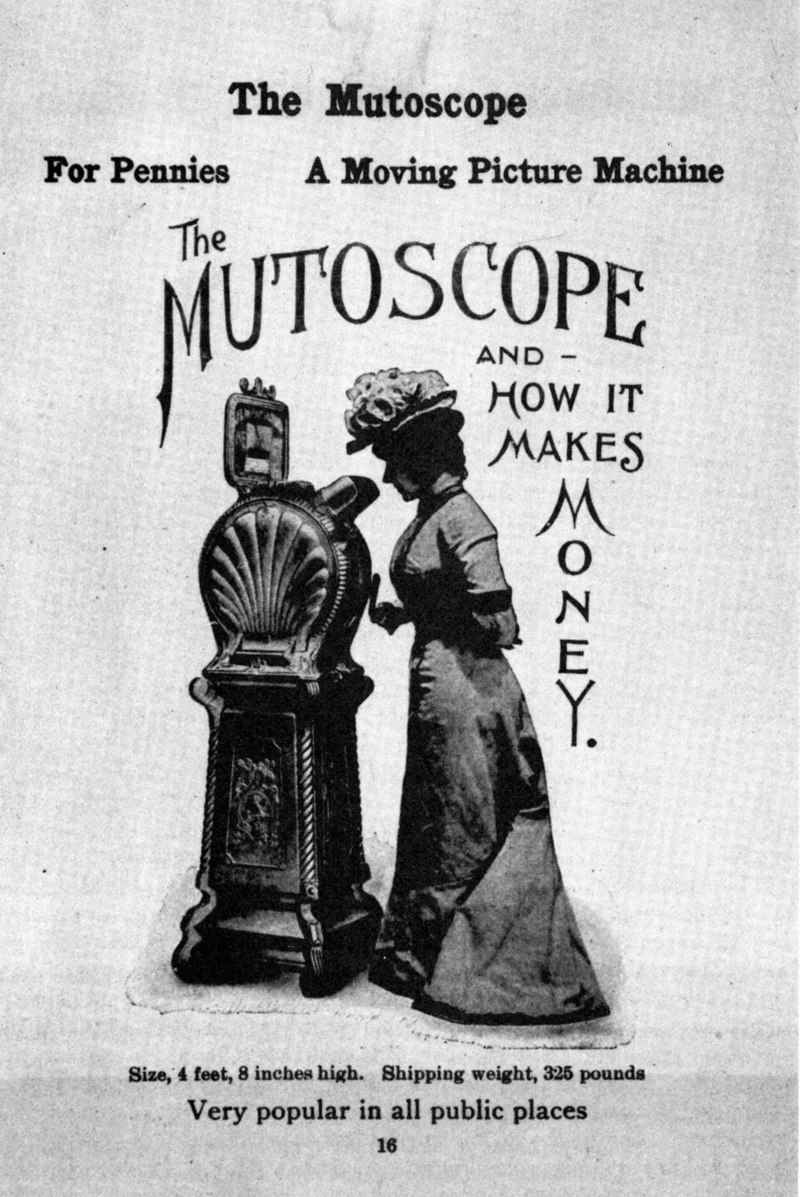
1900
Cinéorama.
Cinéorama was an early film experiment and amusement ride presented for the first time at the 1900 Paris Exposition. It was invented by Raoul Grimoin-Sanson and it simulated a ride in a hot air balloon over Paris. It represented a union of the earlier technology of panoramic paintings and the recently invented technology of cinema. It worked by means of a circulatory screen which projects images helped by ten synchronized projectors.
The film was shot by locking a circular array of ten cameras to a central drive, putting them in an actual hot air balloon, and filming as the balloon rose more than 1,000 feet above Paris. Cineorama’s only public viewing was short lived. It closed after only three days for safety reasons, due to the extreme heat from the projectors’ arc lights. The virtual experience was more dangerous than the actual reality. (source)

1939
Viewmaster.
The Viewmaster (originally a brand name) is a follow up on the stereoviewer. It uses smaller slides, set in a circular cardboard fiche, making it possible to view your own private stereo slide show stories.

1946
Ames room.

Invented by American scientist Adelbert Ames, Jr.
An Ames room is viewed with one eye through a peephole. Through the peephole the room appears to be an ordinary rectangular cuboid, with a back wall that is vertical and at right angles to an observer’s line of sight, two vertical side walls parallel to each other, and a horizontal floor and ceiling. The true shape of the room, however, is that of a six-sided convex polyhedron: depending on the design of the room, all surfaces can be regular or irregular quadrilaterals so that one corner of the room is farther from an observer than the other.
Note: the Ames room was extensively used in the filming of Peter Jackson’s ‘Lord of the Rings’, especially in Hobbit-Gandalf scenes.
1962
Sensorama.
(VR, or the ‘Multiplying of artificial worlds’)
There’s some debate on how to define VR (Virtual Reality) and when it was used first exactly. Is a stereoviewer VR? Does an immersive diorama count as VR? Or a panorama? Or the perspective of a Renaissance painting?
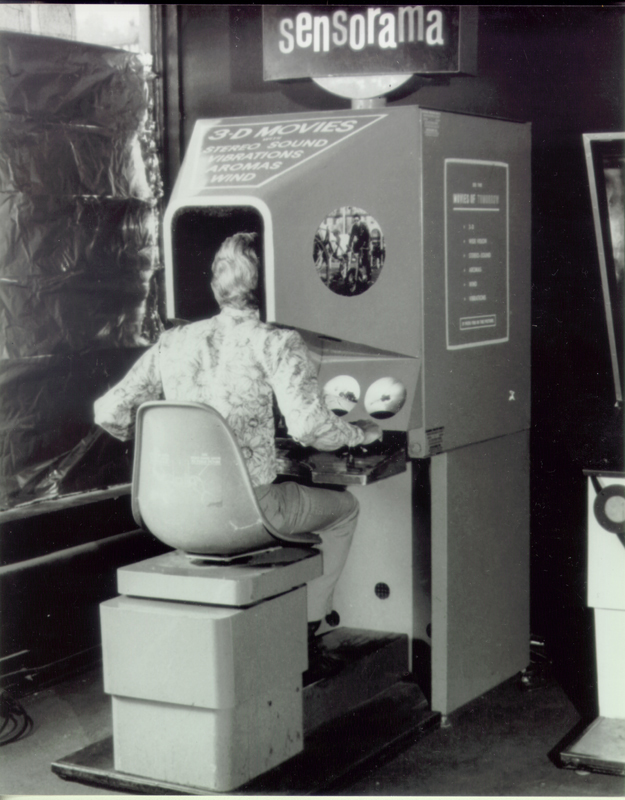
Morton Heilig – a ‘multimedia specialist’ – first wrote about ‘experience theatre’ in 1950. In 1962 he built a prototype, the Sensorama, a mechanical device, including a stereoscopic color display, fans, odor emitters, stereo‐sound system, and a motional chair. It simulated a motorcycle ride through New York by having the spectator sit in an imaginary motorcycle while experiencing the street through the screen, fan-generated wind, the simulated noises, and smell of the city.
1968
The Sword of Damocles.
The first VR headset was so heavy, it had to be suspended from the ceiling in order to be able to wear it, hence its name.
The environments were simple wireframe rooms.
In 1985 the ‘EyePhone’ was developed, which looked a bit like a modern headset, only with clunky movements and a terribly low resolution: transporting the viewer into a candy-colored polygon nightmare rather than providing an immersive experience.
The entire Eyephones system, including the computers required to run it, cost upwards of $250,000.
Follow ups were a.o. the Oculus Rift, and cheap, lens-fitted devices that work with a mobile phone. These are remarkably similar to the 19th century stereo viewers.
1987
GIF animation.
2010
(apprx.)
#wigglegram
or Wiggle stereoscopy.
Left and right images of a stereogram are animated. This technique is also called wiggle 3-D or wobble 3-D, sometimes also Piku-Piku (Japanese for “twitching”).[1]
The sense of depth from such images is due to parallax and to changes to the occlusion of background objects. In contrast to other stereo display techniques, the same image is presented to both eyes.

2013
(Apprx.)
Split Depth GIF.
An animated form of forced perspective. See also this link.
Occlusion (also referred to as interposition) happens when near surfaces overlap far surfaces. If one object partially blocks the view of another object, humans perceive it as closer.

2364
Holodeck.
The Holodeck is first used in the 1987 pilot of ‘Star Trek: The Next Generation’.
A Holodeck creates a completely virtual and deceivingly real environment for the crew to relax in, or to train for battle.

“After everyone left, the holodeck transformed itself into something as close as possible to a real environment.”
